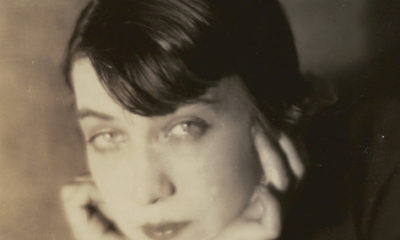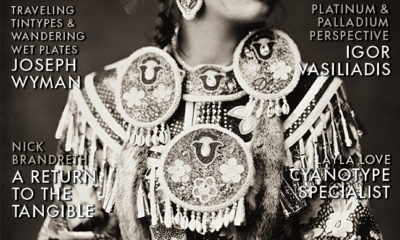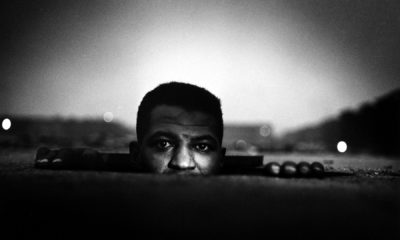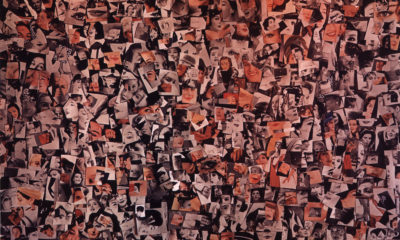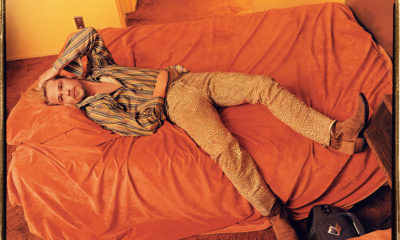Curator Interviews
Katherine Ware
At vero eos et accusamus et iusto odio dignissimos ducimus qui blanditiis praesentium voluptatum deleniti atque corrupti.
Published
2 years agoon
(Former) Curator of Photographs at the Philadelphia Museum of Art
By Kay Kenny
Katherine Ware is the Curator of Photographs in the Department of Prints, Drawings and Photography at the Philadelphia Museum of Art. She traveled to the East Coast in 1999, leaving her position as the Assistant Curator at the J. Paul Getty in Los Angeles. While at the Getty, she organized “A Practical Dreamer: The Photographs of Man Ray,” 1998–1999 and “Vision in Motion: The Photographs of László Moholy-Nagy,” 1995. Known for her expertise in early 20th-century photography, she is rapidly expanding that knowledge as a frequent juror and reviewer of contemporary photography exhibits, including the first Fotofest in China in 2006.
Your master’s degree in art history is from Berkeley, and your previous museum experience before coming to Philadelphia was all on the West Coast. Is that where you grew up?
I grew up outside Dayton, Ohio, where my parents still live. My first job out of college was in D.C., at the Smithsonian Institution Traveling Exhibition Service (SITES), where I was able to get involved in a variety of projects. That experience before graduate school cemented my desire to work in a museum and also to concentrate on photography. Working next door to the Hirshhorn Museum and Sculpture Garden was a thrill for me, and I saw a lot of art during my three years in Washington. Sarah Greenough did an important Stieglitz show at the National Gallery that I saw, and I remember a show of Laura Gilpin’s stunning platinum prints at the National Museum of Natural History. I visited the Corcoran Gallery of Art regularly, and I bought my first photograph in D.C., a print by Ruth Thorne-Thomsen from the Jones-Troyer Gallery. When I was working at SITES, I met a graduate intern named Deborah Klochko (now the director of the Museum of Photographic Arts in San Diego) who was very influential in stimulating my pursuit of photo history.
You once told an interviewer that as a child you used to play “museum” arranging your collections in a neighbor’s garage and charging admission. Was your ambition always to be a curator?
I’m not sure I knew about curators, so my model was perhaps more that of a park ranger. There was a wonderful naturalist named Paul Knoop at Aullwood Audubon Center, near where I grew up. He knew all about plants and animals and was passionate about cultivating a love of nature in others. I wanted to be like that, to learn about and care for things in the world around me and to share my enthusiasm and knowledge. It’s a slightly different kind of stewardship that I do, but both are grounded in respect, study, love and connoisseurship. And both are vital to the well being of the human beast. Identifying a bird hidden in a tree by its call and recognizing an artist’s style in a work of art are the same kind of pleasure to me.
You left the Getty Museum where you were an Assistant Curator in Photography to become Curator of Photographs at the Philadelphia Museum in 1999. Did you find the transition to the East Coast a remarkable change? Did it provide you with a different perspective on the kind of photography that interested you?
Being at the J. Paul Getty Museum for nine years was an incredible opportunity because the history of photography is so richly represented in that collection. But until recently, the Getty did not actively collect the work of living artists, so one of the biggest transitions for me in coming to the Philadelphia Museum of Art was to quickly become better informed about contemporary photography. The best part was discovering the vibrant artistic community in Philadelphia, which was entirely new to me. Historically, the city has been an important place for photography; the 1970s were a tremendously fertile time here, and right now seems to be another peak moment.
“Being at the J. Paul Getty Museum for nine years was an incredible opportunity because the history of photography is so richly represented in that collection. But until recently, the Getty did not actively collect the work of living artists, so one of the biggest transitions for me in coming to the Philadelphia Museum of Art was to quickly become better informed about contemporary photography.”
Katherine ware
Surrealism seems to be one of your specialties. At the Getty, you organized the exhibit “A Practical Dreamer: the Photographs of Man Ray” and published the catalogue just before you left for Philadelphia. Shortly after you arrived in Philadelphia, the museum acquired the Julien Levy Collection of Photographs in 2001. In the nearly 2,000 photographs there were many from artists closely associated with the Surrealists. Levy’s New York City gallery was the first to mount an exhibit on Surrealism and was a major influence on the Museum of Modern Art’s exhibit on the subject in 1936. Is it just coincidental or serendipitous that such a collection came to the museum shortly after you assumed the curatorship?
As someone who has specialized in inter-war and early 20th-century photography, it’s a dream come true to be able to work with the photographs assembled by Julien Levy for his gallery in the 1930s and ’40s (see “Dreaming in Black and White: Photography at the Julien Levy Gallery,” Philadelphia Museum of Art, 2006). Discussions about bringing the collection to Philadelphia began after I arrived, and I was certainly involved in evaluating the collection and the research that went into demonstrating its significance and how it would connect with and transform the present holdings. But the negotiations were conducted by our Senior Curator of Prints, Drawings and Photographs, among others. We had the support of the director and several trustees who collect photography, one of whom ultimately made the acquisition financially possible. One of the special things about the collection is that, placed together with the Levy holdings at the Art Institute of Chicago and the Fogg Museum at Harvard University, we have a fairly complete record of what Levy was looking at in the early ’30s, what images attracted him, what was available. To me that’s very exciting, and it increases our knowledge of that period.
The Levy collection also contains a large number of photographs by Atget. You remarked at the time, “The Levy material would be a prize if it consisted entirely of its group of Atget prints alone. Together with the photographer Berenice Abbott, it was Levy who helped to rescue Atget’s photographs at a crucial moment when they could have been lost forever.” Were you referring to the dangers of World War II?
Perhaps I overstated that a bit, but I was referring to Abbott’s extraordinary personal involvement with preserving Atget’s work and bringing it to the public. Atget died in 1927, and his executor was a friend who was certainly aware of the importance of Atget’s prints and negatives. For instance, he arranged for a large group of negatives to go to an agency in Paris that handled images of historical monuments. And there’s evidence that at least one other person besides Berenice Abbott was interested in buying some of the material. But Abbott was truly passionate about the work and committed to saving it, so she prevailed in purchasing it and later asked Levy for financial support. The fact that so much of Atget’s work survives is largely due to Abbott’s dedication to keeping the contents of his studio together and getting it into the Museum of Modern Art in New York. It certainly didn’t hurt that she brought the goods to New York where it wasn’t subject to wartime depredations. The museum did an exhibition in 2005 on Levy’s collection of Atget photographs, so for those who want to know more or see some of those images, take a look at the book Looking at Atget by Peter Barberie, our Horace W. Goldsmith Curatorial Fellow in photography.

Another timely exhibit organized by you for Philadelphia was “The Secret Life of Buildings: Photographs by Clarence John Laughlin” from December 2006 to April 2006. Laughlin was known primarily as a New Orleans photographer whose photographs of decaying southern architecture in the ’40s are downright spooky in the wake of Katrina. Clearly you must have planned this exhibit far in advance of the hurricane, but what timing! Despite that extraordinary happenstance, Laughlin’s connection to Levy and the surrealists seems far more likely in the planning of this exhibit. Did many of the images come from Levy’s collection?
You’re right that during my research on Julien Levy I got very interested in Laughlin, one of the last photographers whose work was shown at the Julien Levy Gallery. Levy retained only a few Laughlin photos that we were saving for the survey of the Levy collection, so “The Secret Life of Buildings”was drawn from the museum’s prior holdings. Laughlin was effectively the incarnation of Levy’s ideals at the time, a photographer making relatively unmanipulated photographs of American vernacular subjects that had a distinct otherworldly bent. So he was on my mind when Hurricane Katrina blasted a hole in our country, and we decided to do the exhibition on relatively short notice. Laughlin was deeply concerned with preserving the distinctive architecture of Louisiana, so that fit with the moment. I also realized at some point that the museum has had a solo show of his work about every 30 years: a traveling show in 1946; a 1973 traveling retrospective organized here by Michael Hoffman; and the 2005 show you mention, which was drawn from the group of images acquired from the Hoffman show.
Along with your interest in modernist photography you seem to be spending a great deal of time working with contemporary photography. You have been a jurist for many tri-state area exhibits, and you have spent time reviewing photographs at FotoFest and Santa Fe Center for Photography. You once remarked, “At the Getty, I worked only with the dead.” What say you to working with the living?
One benefit of living artists is that usually you can get them to answer your research questions! When I was working on an exhibition at the Getty of László Moholy-Nagy’s photographs, I did visit his grave in Chicago to ask him some things. He never was much of a believer in having one right answer about photography, so it was a fool’s errand, but at least I got to pay my respects. Now I am working on a retrospective of the work of Dave Heath, who lives in Toronto, so he can be my test case on working with the living.

In terms of reviewing work in juried shows or portfolio reviews, I find it really exciting to see what people are making and to connect with them about it. In 2006, I had the wonderful opportunity to participate in the first FotoFest in Beijing, which was an amazing experience (see www.fotofest.org/abroad/china/china06.htm). I’m more of an “encourager” than a “critiquer,” so I find a lot of work stimulating, but have to be stringent about what gets collected and exhibited. There are people doing very good work who just aren’t going to have a retrospective, and I am eager for them to recognize their talents and accomplishments with other landmarks.
Before you became the photography curator at the museum, Michael Hoffman served as adjunct curator from 1968 to 1998. He was also the executive director of the Aperture Foundation in New York and was closely allied with Minor White. Aperture published many of the catalogues for the museum photo exhibits. Does the museum still have ties to Aperture?
Not in any official sense, but of course Aperture looms large on the horizon for anyone interested in photography. I am impressed and heartened at how they have revitalized themselves as an organization. They’re like a rock band of virtuosos who also know how to play together—Melissa Harris on the magazine, Diana Edkins on the exhibitions, Lesley Martin on publications. As director, I guess Ellen Harris is their lead singer and oversees a really interesting slate of public lectures and programs.
Hoffman’s interest in photography included championing many contemporary photographers. Was it his collection that provided the core of the museum’s contemporary photography collection?
Michael did some important early shows of historical photographs, but he clearly loved working directly with the artists whose works he believed in. He showed Robert Frank’s photographs here in 1969 and made sure a strong group of prints was added to the collection. At the beginning of his tenure, he organized exhibitions with Minor White, Paul Strand, Jerry Uelsmann and Clarence John Laughlin that resulted in the acquisition of significant groups of photographs. He also made a commitment to the work of Robert Adams, Danny Lyon, and later, Nick Waplington. After Michael died, a group of his friends organized a tribute collection so that many of the artists who knew him could give work in his memory, and that was donated to the museum. So the collection strongly reflects his vision and taste. One of our founding collections is of work by Alfred Stieglitz that Georgia O’Keeffe donated in 1949, and we have other voices in the mix including Dorothy Norman, whose collection is here; trustees such as Robert Hauslohner, who was an avid collector of Ansel Adams photographs; former Associate Curator Martha Mock, who worked with the photography collection for many years; and our community of collectors and committee members, who bring their own finds to our attention.

Is this something you will continue to pursue—especially in light of all your opportunities to view contemporary photographs as part of your jurist activities?
The collection is at the center of what we do here at the museum, so adding to it is one of my most important duties. It’s always a seesaw between adding work to strengths we already have and wanting to augment the present holdings with new things that are not represented. My goal has been to internationalize the collection a bit more, because photography is such a global medium. As counterpoint to that, we’ve also been trying to keep pace with photographers working locally. I’d love to build a top-notch collection of photograms here, in tribute to Philadelphia’s native son Man Ray. And I would be delighted to impose my own peculiar tastes on the collection—abstractions, mixed-media, work that explores our inner lives, slightly ignored photographers from the ’20s and ’30s, new work by up-and-comers. Fortunately, having so many competing priorities and unexpected opportunities keeps it all in balance.

The Philadelphia Museum of Art is located at 2600 Benjamin Franklin Parkway, Philadelphia, 19130; 215.763.8100.
Kay Kenny is a photographer, writer, and teaches photography at ICP and NYU. Examples of her work can be seen at www.kaykenny.com.
You may like

The Corcoran Gallery of Art occupies an unusual place in the federally funded landscape of Washington DC museums and galleries. Surviving as it does: a long-established private institution bobbing up and down through waves of controversy, applause and economic crisis, it is a school and a museum and probably closer to the heart of the Washington-area art scene than it’s heavily endowed neighbors. Now under new leadership, it is poised for change. Paul Roth, the Corcoran Gallery of Art’s Curator of Photography and Media Arts, is ready for the challenge: his areas of expertise are postwar American photography and the history of film. Politics and art fascinate him. Looking at images: anxiety and discomfort provoke him. The Corcoran, with its privately funded flexibility in this government town seems like the ideal place for this curator.

Your background is a degree in Art History at the University of Arizona in Tucson. Was curating art always a goal?
I first wanted to be a photographer. I was lucky enough to grow up in Tucson, where one of the best high school programs for photography is located at Tucson High School, and I trained there and thought I would become a photojournalist. When I was 18 I looked for work at the Center for Creative Photography at the University of Arizona, a place I had visited since I was 14, and I was hired to catalog the Edward Weston Project Print Collection. This was an amazing leap on their part, to hire a teenager to do something like that, and it changed my life. I decided to become a curator while working there during the next five years. I’m not sure what lead directly to that decision; I was there because I loved the medium and liked being around pictures. It consumed me. I was able to do many things and had access to their great collections of photography and archival materials, and in time it just seemed obvious that my career would be in curating.
You’ve been with the Corcoran Gallery of Art for over 11 years. Were you a photography intern at another museum prior to that? When did your fascination with postwar American photography grow into a passion?
I’ve worked at three museums. From the Center for Creative Photography I went to the National Gallery of Art in Washington, where I worked for Sarah Greenough as the archivist for the Robert Frank Collection and served as the assistant for the retrospective Robert Frank: Moving Out. After Moving Out was completed I was hired at the Corcoran by one of that exhibition’s curators, Philip Brookman. Between the National Gallery and the Corcoran I worked briefly at the Library of Congress and the Washington Project for the Arts on specific projects. I’ve had incredible luck in that I’ve always worked for great people and had fascinating jobs with great collections. “Learning from the experience” has become the meaning of my life.
The amazing access I had to the work of Robert Frank is what drove me to specialize in post-war American photography. It’s unfashionable to use the word “genius” these days (and he probably doesn’t like hearing this) but Robert really is one. For 4 ½ years I was able to work every day with his work prints, proof sheets and negatives, and to think exclusively about his photography and his books. I began to think of American photo history as it led to him and grew out of his influence. Ultimately my understanding of art, politics and life was affected by his visual legacy.
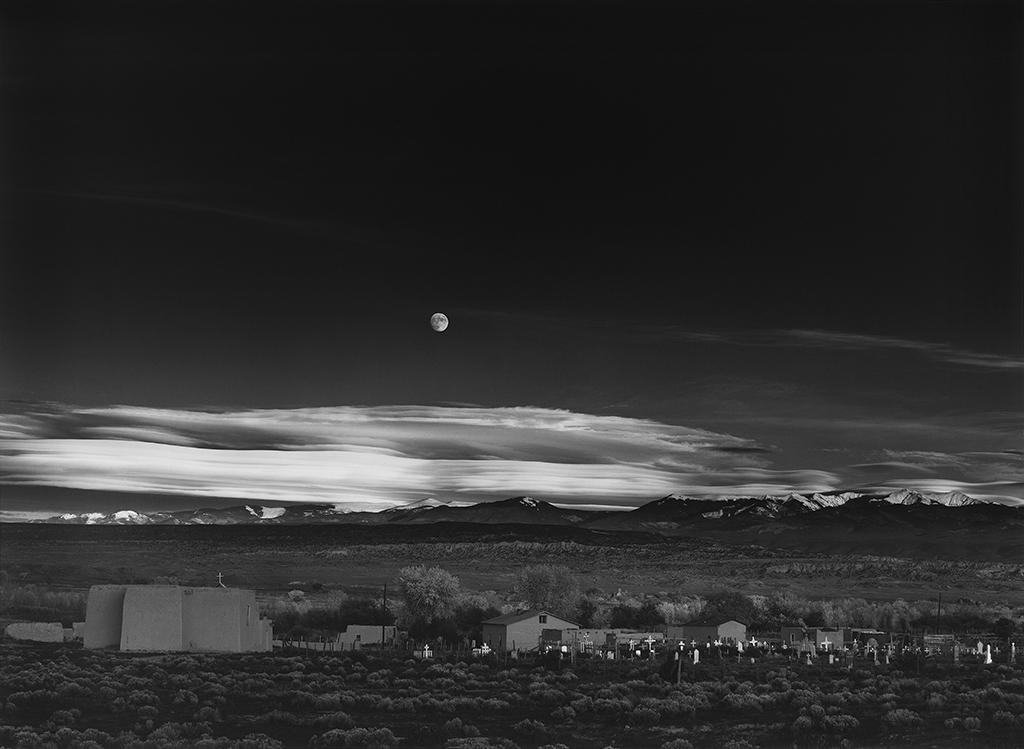
In addition to your work as a curator, you also teach the history of film and you have organized a number of film series for the National Gallery including “The Films of Gordon Parks,” a photographer who donated 227 of his works to the Corcoran, following an exhibition of his work. Now that we have entered the digital age and high quality DVDs are readily available, do you see more still photographers creating narrative film-like presentations and more collectors turning to film and video as collectible?
A couple years ago I saw a multimedia narrative presentation of still and moving images by an artist while judging work for a grant-making organization. It was an amazing packaging of disparate documentary works on a single subject. Unfortunately I have seen nothing like it since. Some individuals are collecting media arts in digital form, though very few have offered such works as gifts to the Corcoran. I’m not sure whether the number has increased dramatically in recent years, though certainly more artists are making work for presentation on DVD, whether in installations or as projected pieces. The collectors I know of who acquire lots of projected media works are the bravest ones, the ones collecting on the cutting edge, the ones least concerned with displaying the object quality of their acquisitions.
The Corcoran Gallery of Art is rooted in Washington DC’s history. As a privately funded museum in 1869, it was founded “for the purpose of encouraging American Genius.” William Wilson Corcoran, the philanthropist whose collection of American Art was the basis of the museum, is reputed to have bought work only from artists with well-established reputations. Today the Corcoran stands in the shadow of much larger government-funded Washington museums. Competition is fierce and photographs from well-established artists have reached the same stratospheric heights as painting and sculpture. Does the Corcoran still adhere to its founder’s dictum of collecting only blue-chip art?
“Blue-chip art” can be interpreted a number of ways: while it seems to generically refer to work of a high quality, it also implies a high prospective investment value, or work by “name” artists, in the sense of “blue chip stocks.” And in that sense we do not acquire only blue chip work, because to do so would violate the very nature of photography, which in my view is a democratic medium. We acquire documentary and vernacular work as well as fine art photography, and we acquire work by younger and lesser-known artists as well as established figures. Both in photography and in contemporary art, collecting means taking risks, and much of the best work in our collection has come because we have tried to remain open-minded and take chances. Having said that, we are currently re-focusing our energies to plug certain gaps in our holdings, and that will mean targeting specific artists and particular works.
We do have many great collections of photography in Washington, some of them vast and encyclopedic in scope, such as those at the Library of Congress, the National Archives and the various museums of the Smithsonian. Because they are here, we do not need to duplicate what they do. And we couldn’t, even if we wanted to. So we try to build our collection and make it better than before.

Considering that photography was in its infancy when William Wilson Corcoran bequeathed his collection to the museum, how did the photographic collection begin at the Corcoran? Was there a major donor who began it with a similar passionate interest in American Photography? According to David Levy, director of Corcoran Gallery for many years prior to resigning in 2005, photography collecting was pioneered by the Museum of Modern Art, the George Eastman House and the Corcoran. Who were those pioneers at the Corcoran?
While the Corcoran is an important part of the story of the institutional recognition of photography as art, we are not pioneers in the sense that MoMA or the Eastman House are. But we did begin accepting photography into the collection in the 19th century, and we began exhibiting photography during the Pictorialist era. William Wilson Corcoran himself is likely the person who brought the first photographs into the collection. But the real “pioneers” of photography at the Corcoran were the people who made the medium an active part of the museum’s program in the late 1960s and into the 1970s and 1980s: Walter Hopps, Jane Livingston and Frances Fralin. They all did groundbreaking work during their respective tenures at the museum.

The Corcoran also is well known for its School of Art and Design (now College of Art + Design) founded in 1890. Is it a common practice for alumni to contribute to the Corcoran’s photography collection?
The collection does include the work of Corcoran alumni and faculty members. From the 1970s on, the museum has been an important force in the local practice of photography, and it was a natural step to reflect that in our collection. We still do so, though we are particularly cognizant of the potential for conflicts of interest. But to give a recent example, last year we acquired works by Joyce Tenneson that were made during the early 1980s when she worked in Washington.
The Corcoran appears to be undergoing a major shift in direction since 2006 when Paul Greenhalgh was appointed as director and president of the Corcoran. The long touted new addition by architect Frank Gehry has been sidelined, exhibition schedules have been dramatically altered, and there is talk of a return to generating exhibitions from the Corcoran curatorial staff rather than relying on exhibitions organized by other institutions. However, the current exhibitions Ansel Adams and Annie Leibovitz: A Photographer’s Life, 1990–2005, both through January 2008, were both organized by other museums. What plans does your department have for fulfilling this new directive?
The Corcoran has and will continue to host interesting traveling exhibitions, just as we organize our own exhibitions and send them out on the road. Both Ansel Adams and Annie Leibovitz: A Photographer’s Life, 1990–2005 are examples of shows organized elsewhere that we thought our audiences would want to see. But we’ve been making our own major exhibitions all along and will continue to do so. Under Paul Greenhalgh’s leadership we are changing the way we make major exhibitions, but I don’t think we are planning to ignore other museum’s exhibitions. We are still always looking to see what is out there that fits well with our program, and we are well aware that we can’t organize every type of show our audience wants to see.
We are planning several major exhibitions that involve photography. Right now I am organizing Richard Avedon: Portraits of Power, a survey of Avedon’s portraiture that deals with politics and power. The work included spans his career and the show will be timed to the American presidential election season, opening just after the conventions in Fall 2008 and running through the end of the inaugural in January 2009. Philip Brookman, who is now our Director of Curatorial Affairs, is organizing an Eadweard Muybridge retrospective for 2010. And a team of our curators is working on a sweeping survey of Postmodernism for 2011, which will include many photography and new media works.
Where will you turn to for these new curatorial initiatives? What feeds your curatorial imagination?
I’m really interested in the intersection between photography and politics, and in the ways that photographers use the medium to reflect the social world. I’m not sure if I developed this interest from being in Washington, or if I came here because this was the perfect place to view the medium through this filter. Working on the Robert Frank archive at the National Gallery, in a building near the U.S. Capitol, was certainly an influence. Seeing how artists think when installing their work in the Corcoran, which is a few hundred feet from the White House, has been an ongoing revelation. Context is so important: we always think about how images reflect the country — and its people, its promise and problems — when considering our exhibitions.
You are a photographer as well as a curator. Your work was included in the Crosscurrents series at the University of Maryland in the 2004 “Room Full of Mirrors.” The 14 artists in the exhibit were described as ‘using the collage aesthetic; incorporating various methods using chance and accident to allow creativity to work through them not from them.’ You have also been involved in a grass roots organization of Washington area artists WPA\C that until recently was part of the Corcoran Museum. You have juried exhibits for many organizations. Clearly, you have a pulse on the kind of work being generated by contemporary and as yet unheralded photographers. What trends do you see there?
Well, interestingly, I don’t feel all that “in touch” right now! I’ve been buried under the work I’m doing on the big shows we have scheduled. But when I do have time to look at new work, I’m really interested in how photographers are evolving their representation of capitalism and its discontents. Gursky’s rational re-orderings of the middle class world of consumption and power are giving way to more explicitly political visions like Chris Jordan. I’m also seeing more work I like that seems suffused with a blanket of anxiety, like that of Amy Stein, Noelle Ta, and Kate MacDonnell, all of whom have roots here in D.C. And I am interested in the ongoing return to earlier photographic processes in the face of the medium’s eclipse at the dawn of digital.
You were also part of a panel discussion, “The Artist’s Responsibility in a Political Environment” that reflected on the role of the artist as a political pundit and activist. Documentary photography has a long established place in political activism but what about the new photography where lines are blurred between the real and the created?
Well, that’s an interesting question. I have to say that I think most fictional, performative and theatrical work is really boring. It is, I think, the most overrated avenue of photography I can think of. Most of the work I see shows just how hard it is to make a single image out of set design and stage direction — usually the work people praise is incredibly awkward, emotionally empty and totally unrevealing. I am kind of fascinated by own negative response, though, and I want to investigate this work more so I can see why I reject so much of the work I see. I recently got Lori Pauli’s exhibition catalog from her show at the National Gallery of Canada, Acting The Part (Merrell, 2006) so I can learn more about it. Maybe it will temper my attitude.
The Corcoran’s Director Paul Greenhalgh was quoted in a Washington Times interview as saying: “This institution should be a think tank. We’re not in the business of pleasing people; we should also challenge and educate.” With that in mind: what would be your ideal exhibition?
My ideal exhibition is a survey of the medium through the notion of the uncanny, first defined by Freud as the state where something is both familiar and foreign at the same time, resulting in profound discomfort and anxiety. This show would look at photography’s history as a vehicle for exploring what lies beneath the visible: the uncomfortable truth below the pleasing, understood and well-ordered surface. My favorite photographs are the ones that destabilize our consciousness rather than confirm what we think we know.
Any plans for that in the future?
Well, fortunately yes! That show is tentatively scheduled at the Corcoran for 2011–12. If all goes well it will be the next big show I work on after Richard Avedon: Portraits of Power.
The Corcoran Gallery of Art is located at New York Avenue and 17th Street, NW, Washington, DC. Please see the Gallery’s website for hours and admission fees.
Curator Interviews
San Francisco Museum of Modern Art Photography Curator Sandra Phillips
Published
1 year agoon
December 25, 2021By
Kay Kenny
Sandra Phillips is Senior Curator of Photography at the San Francisco Museum of Modern Art, an institution that has dynamically supported and collected photography since its opening in 1935. Phillips received a B.A. in art and art history from Bard College in 1967 and an M.A. from Bryn Mawr College in 1969. She earned a Ph.D. in art history in 1985 from City University of New York, where she specialized in the history of photography and American and European art from 1849 to 1940. Phillips has written and lectured widely on photography and is the author or co-author of several books and catalogues. Her recent exhibitions include: “John Szarkowski: Photographs”; “Diane Arbus Revelation”; “Police Pictures: The Photograph as Evidence”; and “Shomei Tomatsu: Skin of a Nation.” Despite the globalization of media and the arts, regional differences are a curious reminder that a sense of place still informs our imagery. Sandra Phillips has an unusual vantage point having grown up with the New York’s MoMA and overseeing the photography collection at SFMOMA.
All of your university degrees, including your Ph.D. from the City of New York, are in art and art history where you specialized in the history of photography along with American and European art from 1849 to 1940. Did you have a primary mentor for the study of photography’s history at that time?
No, but I grew up in New York and loved museums, and I consider myself a student of the work shown at the MoMA. In fact, I remember seeing the show, “New Documents.” I remember seeing the Arbus pictures because I went with a friend, and she thought it would be fun to go. I remember seeing a man spit at some of the pictures in the show.
When did you gravitate towards photography as a field of study?
I come from a family of art people -my dad was an architect, my mom a landscape architect, and I thought I would be a painter, so when I went to school, that’s what I studied. But I became more interested in looking at art, and it seemed really interesting that no one was then taking the history of modern American art really seriously -this was in the 60s. And then when I got more involved in modern American art, it seemed that one of the major contributions was in photography, which was even less studied, and that intrigued me even more.
Under the direction of curator John Humphrey, SFMOMA was one of the first museums to recognize photography as an art form, over 70 years ago. Can you tell us what initiated that recognition and began the process of creating the SFMOMA’s photography collection in 1935, the same year that it opened? Was there a special collection donated to the museum at that time?
The San Francisco Museum of Art, as it was then called, was founded by a group of wealthy local individuals. You realize that San Francisco became a city very suddenly when gold was discovered, so everyone in the world was interested in San Francisco, and the 49ers were here and many of them used the services of the daguerreotypists to send records of their recent fortunes back home. There has been a very strong interest in photography here since the 19th century–remember Carleton Watkins, Muybridge, and others used this as their base. There has never been a tradition of important art created here -that is relatively new, but when the museum was founded in the 30s there was an impressive range of important photographers he could own or lease. This might include tents, caves, pictures made within buildings, etc. He is still an active collector, and I tease him that we’re planning the Return of the Paul and Prentice Sack Collection.
SFMOMA recently received another significant donation from the Emil & Silverstein Collection. What distinguishes this collection from the Sack collection?
This is a very different collection. I would describe the pictures as psychologically informed. It is historical, but the emphasis is on work of surrealist inflection produced in the 1930s and the present. The pictures are also in their own way very personally meaningful to their owners, in a very different way from
the work in the Sack collection.
SFMOMA prides itself as having from the first, viewed photography as a modernist art form. Its collection of over 15,000 prints is known for it’s early American and European modernist photographers as well as Western American Landscape photography. How does modernist photography differ from contemporary photography? Would you define photography in the same terms today as in the days of your predecessor, Van Deren Coke, who established the department of photography in 1980?
I would define modernist photography as photographs which aspire to modern art, and which were made by Americans and Europeans in the 1920s and 30s, essentially. Since I came to the museum, in 1987, I have enlarged the scope to include 19th century and have emphasized our tradition of landscape representation. Coke thought about photography in terms of modernist art -I believe the concerns of contemporary photographers are related but different.
In 1980 the exhibit “California Photography 1945-1980” examined the aesthetic and history of photographic image-making unique to California. Do you think there remains a special sensibility that divides West Coast from East Coast photography?
First, I had nothing to do with the California show, but yes, I would generally say that in the west there is an abiding interest in land use and land issues, which is not generally shared by photographers or audiences for photography in the east.
In California today, what influences define West Coast photography?
There is more of an understanding of Asia here.
Before coming to SFMOMA in 1987, you were the curator at Vassar Art Gallery in Poughkeepsie, New York. Did your experience at Vassar provide you with a heightened sensitivity to women photographers?
Not really, I was there for about a year. But in general, photography has provided women with opportunities not so obvious or available in other fields.
You have organized exhibits and written numerous essays on women photographers, most notable Dorothea Lange in 1994 and Helen Levitt in 1991. Your essay “Women Artists in California & Their Engagement in photography” appeared in the book Art/Women/California 1950-2000. What special concerns faced women photographers in the past, and do you believe that many of those photographers may still be undervalued?
If you mean monetarily undervalued, I suppose you could say that, but this is an aspect of the field that really doesn’t interest me too much. The “concerns” that women faced in the past are ones they -we -face today. If we are mothers who need to work, how do we do this? That is probably the most obvious difference.
There is an interesting story about one of Dorothea Lange’s most famous photos, a migrant farm worker named Florence Thompson. As Lange’s photo gained wider recognition and value, Florence and her children came forward, angry that neither monetary compensation nor a copy of the photo were ever given to them. You recently organized the Diane Arbus exhibit, another controversial photographer often accused of exploiting her subjects. How do you address this issue when the subject comes up?
Well Lange worked for the government, she had a job, and her photographs were made to serve a purpose, one that she very much believed in; then the times changed. I do not think she would have said she was exploiting her subjects. And frankly I don’t feel comfortable with the idea that Arbus “exploited” her subjects either, they look very interested in her, as much as she in them. When she was making these images, they were very new, very raw material. I don’t think you would see anyone today spitting on her photograph of a young man in curlers, as I saw in the MoMA exhibit “New Documents.” I think we’ve become more tolerant, as a culture.
Documentary photographers, such as Dorothea Lange, never anticipated their work on a museum or gallery wall. Their photographs told a story meant for the printed page of national magazines. It seems that today’s documentary photographers anticipate a museum or gallery exhibit along with a well-designed coffee table book. Do you think that the nature of documentary photography has changed to appeal to a more limited audience?
Photography has changed technologically, and the ambition of certain photographers has changed, I think that is the way I would put it. Someone wise once said that the process gets easier but the number of important photographs remains the same. There is a lot of indifferent work being made, but some very interesting work as well.
Many of the snapshots of today, along with the news photos of our time, are in digital form. It is very likely that no “paper trail” will exist in the future for these kinds of images. The history of fine art photography is filled with images that were never intended to be considered fine art. Is this concept lost forever to future collectors and curators?
If so, maybe that is not such a bad option -look at all the bad stuff out there, and consider all the time needed to sort out the good from the dull.
You’ve spent a good deal of research time at the Vatican Photography Collection and recently received a Getty fellowship to return to Rome and continue your research. What special fascination does
this collection hold for you?
It’s mainly unknown work by unknown photographers from all over the world.
With John Szarkowski, you organized a major retrospective on Ansel Adams, in 2001, then curated a major retrospective of Szarkowski’s photographs that recently traveled to the NY MoMA. What’s next for SFMOMA? Any future plans for another major retrospective such as one on Van Deren Coke?
My next big project will be on voyeurism and surveillance. I’m working on a big exhibit about things that are forbidden to be photographed: like violence and death and sexual images. It is also about how we are watched and our ambivalence about photography. It is about a culture that is ferociously looking at images that are taboo.
SFMOMA is located at 151 Third Street (between Mission and Howard Streets) San Francisco, California. For general information call (415) 357-4000 or visit www.sfmoma.org.
Kay Kenny is a photographer, writer, and teaches photography at ICP, NYU and SHU, web: www.kaykenny.com, e-mail:[email protected]
Curator Interviews
Malcolm Daniel: Metropolitan Museum of Art
Published
1 year agoon
December 21, 2021By
Kay Kenny
During a weekday afternoon at the Metropolitan Museum of Art a few tourists straggle in and a woman with a traveling easel and unfinished copy of an 18th-century portrait passes by. Two educators compare their students’ drawings from the Pre-Columbian section. When we meet, Malcolm Daniel, newly appointed Curator in Charge of the relatively new Department of Photography, breaks into a smile. He assures me that while photography has only recently gained a department and curator of its own within this museum’s vast encyclopedic collection, it’s been around much longer.
Photography departments in university art schools were just beginning when you received your B.A. in Art History & Studio Art from Trinity College in Hartford, Connecticut in 1978. Did your art history studies include the history of photography?
No, there wasn’t a history of photography program offered at the time. There is one now. At the time I was studying printmaking and painting. I had visions of being an artist and I was studying the range of art history from ancient to modern. I had a mild interest in photography.
In a way, the most important aspect of my education, one that shaped the career I would follow, was a semester spent in Rome where I had inspiring teachers and the experience of going into the city and studying art history by standing in front of the actual art object and architecture. It was that experience of contact with the real works of art and what you could learn from that contact, that confirmed an interest I already had of working in a museum. It was also true that the more great art I saw, the more humble I felt about my own range in the art world, so I became more and more confirmed as an art historian. I do think that as an art historian I’ve been helped by having had that experience of trying to make art myself. I have a better understanding of how those physical processes work as a result of my printmaking experiences.
Peter Bunnell was a leading force in the development of a History of Photography Program at Princeton University where you received your M.A. and PhD in 1987 and 1991. How did he shape your interest in photography?
That’s really where my interest in photo history blossomed. Before going to graduate school I worked in the education department at the Baltimore Museum -bout five years. While I was there I developed a deeper interest in the graphic arts in 19th-century France and in photography.
At Princeton, having the opportunity to work with primary material in the Minor White Archive, and Peter’s dedication to teaching history with the actual object – it was his instruction, his enthusiasm and his passion that ultimately led me into photographic history. I didn’t go to Princeton to study photo history! I went thinking I would do something in modern painting or sculpture then gravitated towards 19th-century France. I decided, however, to do something that excited me a lot: Work where I could make a contribution. That was the work I had done with Peter in an area of photography where there was still so much primary research to be done.

You were still working on your doctorate in 1990 when you joined the Metropolitan Museum as a curatorial assistant. That must have been an exciting time to be there just as Maria Morris Hambourg began working with Howard Gilman and Pierre Apraxine to shape the Gilman Paper Company’s Photography collection as a compliment to the museum. What was your role as her assistant with this enormously important collection?
Actually, I had been a fellow in 1987 and 1988 in what was then the department of Prints and Photographs and worked with Maria Hambourg at the beginning stages of my dissertation. We got to know each other. I then went off and did a year of research in the archives in Paris. I was writing my dissertation in 1989, 1990 when a position opened up and she held the job open for six months for me so that I could finish the dissertation before starting work. She knew we would work well together.
It was a very exciting moment in the department. We were on the verge of becoming an independent curatorial department. Certainly the great attraction of coming to the Met was the opportunity to work with Maria, whom I admired so much, still admire so much, and from whom I have learned so much, as well as the chance to work with a great collection in an encyclopedic museum. From the moment Maria came to the Met, in late 1985, early 1986, the relationship with the Gilman collection began to build. By 1990, they were already envisioning the exhibition “The Waking Dream” and that collaboration intensified. I’ve always worked with the whole collection but my heart has always been with the 19th century. It’s the period I feel the most passionate about and done the most research in, but the history of photography is relatively short and in this department we all contribute to the discussion about works from the whole history. Each of us have a special area, an area that we love more than others, but we all feel comfortable participating in discussion – that’s what makes it so exciting.
Your area of expertise is described as 19th-century French and British photography. Was it the Gilman collection that brought you to the museum or did you see the Metropolitan Museum’s on-going interest in early photography as a perfect compliment to your own interests? I’m referring to Alfred Stieglitz’s collection of turn-of-the century photographs and the photographs from the Ford Motor Company Collection.
Well, it’s not accidental that Maria Hombourg had a deep interest in 19th-century French photography, which was the area that my dissertation was in, the French landscape and architectural photographer Edouard Baldus. It was an area that she was interested in building within the collection. Part of that was the Gilman Collection, but we also made major acquisitions for the collection in 19th-century French photography since the moment Maria arrived. By the time I got here, the collection had two great strengths, the Stieglitz Collection, which had come in as a gift from Stieglitz in 1933, and the Ford Motor Company Collection acquired in 1987.
The Stieglitz Collection included some of the greatest works by Pictorialist photographers and members of the Photo Succession so we had incomparable strength from the period of 1895 to 1915. The Ford Collection assembled by John Waddell, a great New York collector, is a collection of 500 American and European photographs of an era between the two world wars. That extended our collection up to World War II. Maria’s task was to strengthen what came before the Steiglitz Collection and what came after the Ford Collection.
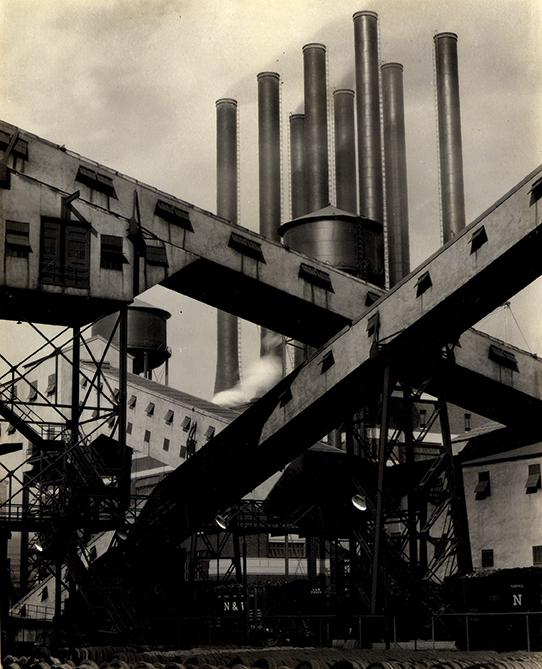
You have also been instrumental in acquiring work from the Rubel Collection and curated an exhibit in 1999, “Inventing a New Art: Early Photographs from the Rubel Collection.” How did that come about?
We had various opportunities throughout the 1990’s to acquire French photographs that trickled out from people’s cupboards and came through auctions and dealers and were pretty successful. We weren’t as successful with the British material. Part of that had to do with the market. In the late 1970’s and early 1980’s there was a great rush of British material to the auction houses as the photography auctions began in the 1970’s in London. Libraries and manor houses emptied out into those auctions as people discovered that there might be value in those old photographs, but the museum did not buy anything during those years! The study of the history of photography wasn’t developed enough yet. There weren’t the books, the tools, there wasn’t yet a connoisseurship, a sense of what the print should look like.
So, after the rush of materials to the auction houses, it all dried up. The William Rubel Collection gave us a second chance. He assembled the collection in the late 1970’s, early ’80’s when maybe only half-a-dozen people were seriously collecting. Rubel put together a very remarkable collection with enormous strength in British photography, particularly those four pillars of 19th-century British photography, Talbot, Hill and Adamson, Roger Fenton and Julia Margaret Cameron.
You founded the Alfred Stieglitz Society about seven years ago. Is this a special interest group dedicated to early photography?
We’ve always had a visiting committee, which is a kind of advisory committee for the department. It’s made up of prominent collectors and a couple of people from academia including Peter Bunnell and Eugenia Parry. She was the person who wrote the book “The Art of French Calotype” but we wanted a way to expand our circle of friends and supporters so we founded this friends group for photography from the past right up to the present. It developed into this very lively and supportive group of about fifty individuals or couples, most of them collectors. The members are by invitation, but we do welcome queries and the members do spread the word. Our one restriction is that it is not open to dealers or people involved in the trade. Members pay dues each year. There are events throughout the year that include visits to artist studios and to private collections, tours of our exhibitions and curatorial seminars working with the Met collections. We balance our program with 19th century, vintage 20th century to contemporary photography. For instance, this year Jeff Wall spoke to us at our first event of the year. We just made a major acquisition of Wall’s work. The main event is a dinner each spring in which the curators present works of art -cquisition and the members vote on what their dues money is to be spent on. Of course, all of the work we present is work that we want and most times we’ve been very fortunate and individual members have stepped up and said, ”If the group doesn’t vote for this, I’ll contribute the funds!” Usually we’ve been able to acquire almost everything we’ve presented.
You were appointed an assistant curator in 1993, the same year that “The Waking Dream: Photography’s First Century,” a huge exhibit of photography from the Gilman Collection, was exhibited. The Department of Photography was only created in 1992. What took so long for the Museum to formally recognize a department of photography?
Well, this museum collected photography before MOMA was founded. It’s important to us now that we are a separate department, but the Met began collecting photography in 1928. It was in the purview of the Prints department but we had quite visionary curators. The first curator of the Print Department was William Ivins followed by Hyatt Mayor. Both of them had an all-encompassing sense of what constituted the graphic arts. In the fifties John Mckendry was at the helm. He had connections to the fashion world and brought in a little more contemporary photography. When Weston Naef came in first as a college intern. then as assistant curator, he took photography as his bailiwick and focused on building the collection further. So there was a sustained interest but no pressing need to make it a separate department.
When Maria came in 1985 she was the first curator specifically hired as a photography curator and the first to have done her doctorate with a focus on a photographer. She came in as an associate curator prepared to lead such a department. It took a little time to establish it. She came in and built the collection through the Ford Motor Collection acquisition and made her mark through various exhibitions. The director and the trustees saw what she was doing and understood that photography had its own history. I think that it’s more remarkable that this museum has been collecting photography for eighty years than that it didn’t have a department of photography until 1992.
By the time you assumed the post of Curator in Charge, in 2004, the museum had already started to vigorously collect more contemporary photography. It seems as if the museum was trying to rapidly make up for lost time. Do you see a major shift in that direction at this point?
I think that’s true. We have always collected right up to the present day but as long as Maria’s been here and I’ve been here we have exhibited contemporary photographers. But I do think, with the acquisition of the Gilman Collection giving us such great strength in the first hundred years of photography and setting so high a standard in terms of image and print quality, that there would be fewer and fewer acquisitions of 19th-century and vintage work needed to fill the gap in our collection. Our acquisitions will be focused on the period from 1960 to the present and, of course, new work is being made every day!
Your curatorial interests, on the other hand, seem to remain largely in the 19th and 20th century. You curated the exhibits “Edgar Degas, Photographer” in 1999, “The Dawn of Photography: French Daguerreotypes” in 2003 to ‘04, and most recently “All the Mighty World: The Photographs of Roger Fenton, 1852–1860” in 2005. Do you see your interests changing with the museum’s growing interest in contemporary photography or is this an area that is dearest to your heart and likely to remain so?
Yes, my heart remains in the 19th century, there’s no question! I find it a remarkable moment particularly in the 1850’s when photography was fully mature and taken up by trained artists and yet it was still a hand-crafted medium. It hadn’t yet been industrialized. There were such glorious pictures being made by French and British photographers and American photographers.
Who, among your staff, advises you on contemporary photography? What kind of work or trends are they bringing to your attention?
There are two people. The first is Douglas Eklund; he’s an assistant curator whose area of specialty is 1950 to the present. He’s working on a show called “The Pictures Generation: Cindy Sherman, Richard Prince, and Laurie Simmons.” Louise Lawler is currently scheduled for 2009. It should be a great show! He’s the staff member who is most frequently out in the galleries, meeting with artists, meeting with dealers and collectors.
However, we also go out as a department once a month and Doug has usually gone out and done the scouting around and figured out what is most important for us to see as a group. The second person is Maria Hambourg, who after several years of being on leave has returned part time. After doing so much in the 19th century and early 20th century, what she’s finding most exciting is the contemporary world and she’s working closely with Doug in that area.
Now that the Gilman Paper Collection is officially part of the museum’s holdings, would you say that the Met has become the preemptive power in world-class photography collections? Any rivals to this collection of over 8,500 images?
Yes, there are rivals, but I think it places us in the highest rank. It’s very hard to compare collections. In terms of the 19th century our only rival is the Getty Museum. If you compare us to MOMA, certainly MOMA is stronger in classic 20th-century photography. If you compare us to the Museum D’Orsay, yes they have a stronger French 19th-century collection. If you look at the National Museum of Photography, Film and Television in Bradford, England, with their acquisition of the Royal Photographic Society collection, they have great strength in turn-of-the-century material like the Stieglitz collection. They have the second highest concentration of Pictorialist photography in the world and they have an unrivaled collection of 19th-century British photographers.
You participated in a panel discussion recently at the Met in conjunction with AIPAD. The panel’s theme was “Collaboration: Collector & Curator” and you shared the stage with Pierre Apraxine of the Gilman Paper Company Collection, as well as several other museum curator and collectors. Are you still working with Mr. Apraxine to acquire new works?
In an informal way. Pierre has a suburb eye and experience, so we ask his opinion about work few are considering -cquisition, or ideas for exhibitions. The next installation to open in the Gilman Gallery in February titled “Sight Unseen” is from the Gilman collection—photographs that have never been shown in the Met before. Pierre worked with associate curator Jeff Rosenheim to choose the work for the exhibit. We rely on Pierre for the history of that collection. He knows more about those pictures than anybody else. He was the curator for the recent exhibition “Spirit Photographs.”
While the Howard Gilman Gallery is a wonderful showcase for earlier photography it can’t accommodate the large-scale images of many contemporary photographers. Any plans to create a permanent gallery for this work? Do you foresee any future trends that indicate another great shift in the photographic horizons?
Yes, though the details can’t really be announced yet, funds have been donated and plans are very much alive – gallery of contemporary photography that would be appropriate in scale and space to view photography of our own time. Our notion of what constitutes a photograph is expanding so we will continue, carefully, and slowly, to acquire works of video and new media that seem to mesh with our interests in photography. It may be that the modern art department also collects in that area and we hope there will be communication and collaboration. After all, we are all one museum and I wouldn’t want to see the history of photography divorced from the contemporary expressions of that medium!
The Metropolitan Museum of Art is located at 1000 Fifth Avenue at 82nd Street, New York, NY. For general information call: 212.535.7710 or visit
www.metmuseum.org.

Happy Birthday, Berenice Abbott

New: Focus Magazine Returns To Print

GORDON PARKS: A CHOICE OF WEAPONS

Paris Photo 2021 Review

A Trillion Sunsets

Happy Birthday, Berenice Abbott

New: Focus Magazine Returns To Print

GORDON PARKS: A CHOICE OF WEAPONS

Arthur Tress: Finding Us In The Other

Dare To Go

What I Did Over Summer Vacation
Trending
-
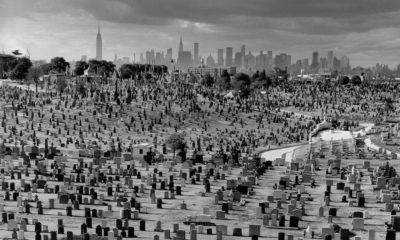
 Photographer Focus1 year ago
Photographer Focus1 year agoArthur Tress: Finding Us In The Other
-
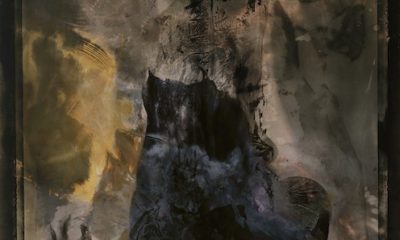
 Collector's Focus1 year ago
Collector's Focus1 year agoDare To Go
-

 Collector's Focus1 year ago
Collector's Focus1 year agoWhat I Did Over Summer Vacation
-
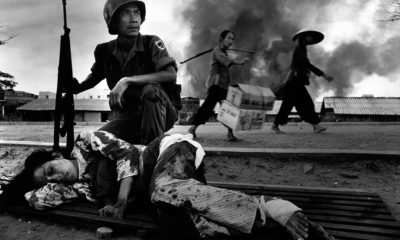
 Collector's Focus1 year ago
Collector's Focus1 year agoMagnum Photos
-
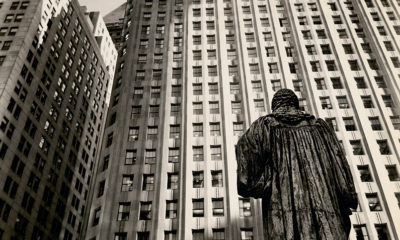
 Vintage Focus1 year ago
Vintage Focus1 year agoBerenice Abbott
-
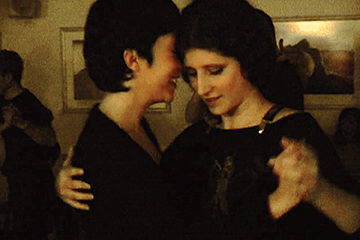
 Collector's Focus1 year ago
Collector's Focus1 year agoSPEAKING OF TRENDS…
-
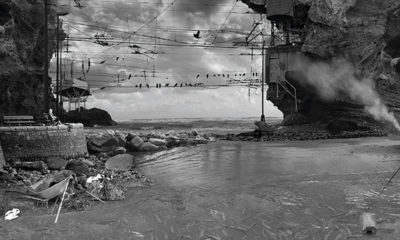
 Collector's Focus1 year ago
Collector's Focus1 year agoGallery Trends
-
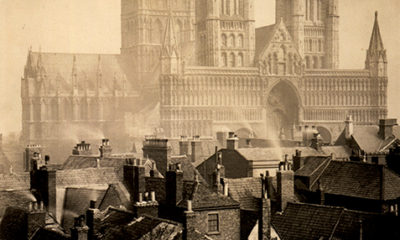
 Vintage Focus2 years ago
Vintage Focus2 years agoFrederick H. Evans

